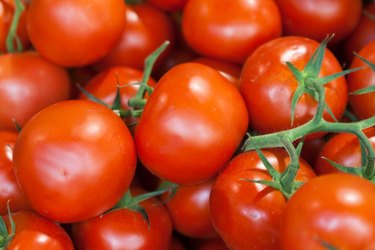
Fertilizers contain nitrogen, phosphorus and potassium, essential elements that plants need to thrive. Before applying fertilizer of any kind, have your soil tested by a local university or county extension office or use a home soil test kit. Liquid fertilizers can offer a quick nutrient boost to growing vegetables when applied to roots, sprayed on foliage or added to the water supply. Vegetables need different fertilizer types at various stages of development.
Starter Plants
Video of the Day
Some types of vegetables, such as peppers, eggplant and tomatoes, require a long growing season and do best if started indoors. Thinned seedlings do well with a liquid fertilizer consisting of five parts nitrogen, ten parts phosphoric acid and five parts potash, or 5-10-5. The University of Minnesota Extension recommends mixing 1.5 tablespoons of fertilizer with 1 gallon of water to create a liquid fertilizer. Apply 1/4 cup of the liquid to each seedling once every two weeks. Rinse the plants' leaves with water after application to prevent leaf damage.
Video of the Day
Transplanting
The process of transplanting can be stressful for vegetable plants. Make the transition easier with an application of liquid fertilizer. The University of Illinois Extension recommends a high-phosphorus fertilizer, such as 10-52-17 or 10-50-10. Mix 1 tablespoon of fertilizer with 1 gallon of water and add one cup of the liquid to the roots of each plant when transplanting.
Established Plants
For a quick nutrient boost, liquids can be applied directly to foliage. Known as foliar feeding, this method can be used when "a quick growth response is wanted, when micronutrients such as iron or zinc are locked into the soil, or when the soil is too cold for the plants to use the fertilizer applied to the soil," according to the Virginia Cooperative Extension. Be careful not to use fertilizers with too much nitrogen, as it can burn leaves. Try a liquid fertilizer made from compost tea. Compost tea provides many benefits, including increasing plant growth, suppressing diseases and replaces nutrients in the soil, and is an effective fertilizer for foliar feeding.
The Virginia Cooperative Extension recommends using organic liquid fertilizers made from fish emulsion and liquid kelp on an established vegetable garden. Fish emulsion is made from partially decomposed fish and contains a high nitrogen content such as 5-1-1. Be careful not to overuse fish emulsion, as it can burn leaves. Liquid kelp comes from seaweed extracts, and generally has a nutrient composition of 9-2-7. Kelp provides a variety of nutrients, but can be more expensive than fish emulsion.
- Virginia Cooperative Extension: Fertilizing the Vegetable Garden
- University of Minnesota Extension: Planting the Vegetable Garden
- University of Illinois Extension: Vegetable Garden Guide
- The Vegetable Garden: A Liquid Fertilizer Can Help Vegetables Thrive
- Pennsylvania Department of Environmental Protection: Compost Tea as Easy as 1 2 3
- Go Organic Gardening: Organic Fertilizer